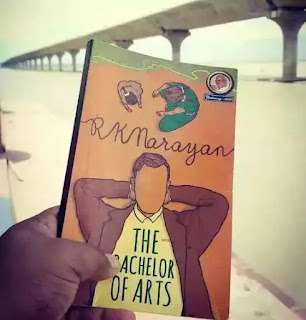The Bachelor of Arts by R K Narayan Summary
His next novel, The Bachelor of Arts, was published in 1937. It is a mature work than the earlier novel and it deals with a later stage in a young man’s career when he is about to leave college and enter life when he is neither a boy nor a man, but somewhere in between. It is divided into four parts: Part I, divided into five chapters, gives us a vivid account of the college life of the hero, Chandran. Practically, every aspect of college life is covered up to illuminate the personality of the hero. Chandran is a brilliant speaker and, so, he is appointed Secretary of the College Historical Association by Ragavachar, professor of history. These extra-curricular activities come in the way of his studies. However, it goes to his credit that somehow he manages to pass the B.A. examination.
Part II deals with the young man in search of a job, and his many frustrations. Within six months of his becoming a graduate, Chandran is faced with the problem of finding a job for himself. Unable to find a job, he passes this time by sleeping for long hours or walking on the banks of the river. During one of his walks, he sees Malathi, a beautiful girl of about fifteen years, and instantaneously falls in love with her. The parents of the girl are prepared to accept the proposal of Chandran’s marriage with their daughter but the horoscopes do not tally and the proposal is ultimately dropped. Chandran feels so much disappointed and upset by this incident that he falls ill and is confined to bed for several days. On recovering from this severe blow, he goes to Madras for a change.
Part III describes his aimless wandering in Madras and other parts of South India. He does not go to his uncle in Madras but stays in a hotel for the night. He visits the house of a prostitute in the company of a degenerate youth. But disgusted, he sets out for Maylapore and sees the magnificent Kapaleswar temple. The peace of the temple attracts him and he turns a sanyasi. He then visits several South Indian villages and districts on foot and lives on alms. After eight months of these purposeless wanderings, he gets tired of his new role and returns to his parents in Malgudi.
Part IV deals with Chandran’s marriage and his settling down in life. On return to Malgudi, he finds that all his friends are scattered and, possibly, already settled in life. He also accepts a humble job secured for him by an influential uncle, forgets Malathi, marries another girl, Susila, and is full of thoughts of his wife. Thus, the novel ends on an optimistic note and gives us the message of the continuity of life flowing on in spite of setbacks and shocks which threaten to block its way. Chandran who had lost all interest in life and had even thought of committing suicide had turned a sadhu, renouncing the world and its luxuries, now comes back to the world. and starts living his life without any memory of the old wounds, “It appears as if nothing had ever disturbed his life. Malathi, who had once upset him much, is now totally forgotten. The wayward, irresponsible, and carefree graduate of olden days is now a respectable man with a sound profession to provide him the wherewithal of life and a wife to look after his household affairs.”-(Raizada)
Though it is primarily the story of Chandran, a few minor characters add greatly to the interest. Of these, the most memorable is Mohan and Kailash. “Mohan is a poet, as a poet in The Man-Eater of Malgudi composing a story of Krishna and Radha in monosyllabic verse; but Mohan’s poetry is not confined to Pauranic stories. He writes on a wide variety of subjects from a roadside grass-seller to the planet in its orbit; from lines suggested by an Ant to the Dying Musician.”
The other memorable character is Kailash, the first of Narayan’s many lovable eccentrics, who offers Chandran beer and takes him to a prostitute’s house. He has a simple philosophy: “a man must spend forty years in making money and forty years in spending it.” Narayan has succeeded in making even his minor characters convincing and real. The novel is also remarkable for its skillful mingling of humor and pathos. It is a great work of art and well deserves the attention that has been given to it.
